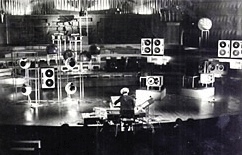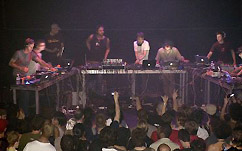in the Age of Supercomputing
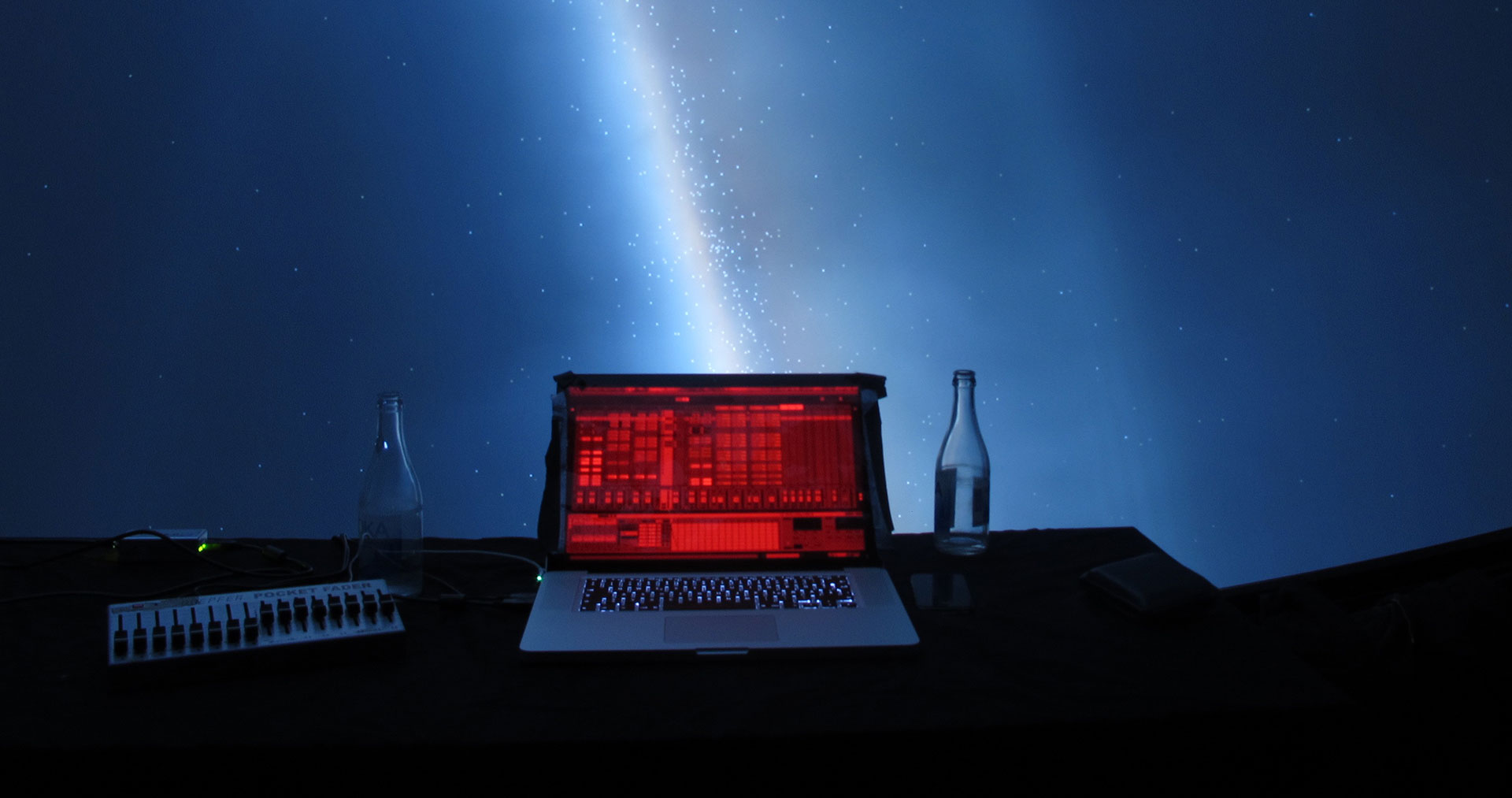
This fragmentary text, written in Summer 2007, is the attempt to sum up some thoughts of mine about performing electronic music live. Since starting to put chapters online I got numerous very interesting comments and links to publications and i'd like to thank you all for the feedback!
There is much more I would want to add but most likely I will not find the time and the text will stay fragmentary.
And here is some kind of second part of this text, written in 2009
Lots of things have been written and said about live electronics,
especially since so many of us are occupying the stages of clubs and
festivals with our laptops. As a description for this kind of concert
the term laptop performance was invented, probably by journalists who
were desperate to find a catchy icon for what they saw and could not
categorize. I do not like that term so much. To me the laptop is
just another musical tool and the only reason why I am using it on
stage is the simple fact that it is a portable supercomputer,
capable of replacing huge racks of hardware.
The laptop itself does
not contribute anything by its own, we do not write a Symphony for
Dell, perform a Suite for six Vaios or Two Crashes for Power PC,
unless we want to be very ironic. What makes it an instrument is the
software running on it. And this is where things start to get
complicated. The audience looks at a laptop whilst listening to
music. But what exactly creates the music and how the performer
interacts with this tool is completely non-transparent. The laptop is
not the instrument, the instrument is invisible. And to obscure
things even more we have to realize that most of the time there is
not one single instrument and it is not "played" by the performer.
What really happens and what remains completely non-decodable for the
audience is more described as a huge number of instruments played by
an invisible band sitting inside the laptop. The only visible part is
the performer conducting the work in a way which looks extremely
boring in comparison to the amount of physical work carried out by the
guy forcing a full blown orchestra of stubborn professional musicians
through a symphony. The minimum difference between pianissimo and a wall
of noise? One pixel, 0.03mm.
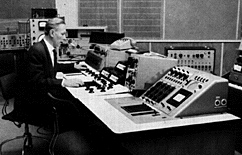
Siemens synthesizer, around 1955
Contributing to that miracle called laptop live act is the fact the
audience would not even get much useful information from the
knowledge of what software is running on that computer, since in most
cases the software used for performing is not the same as the one
used for creating the music. Even if it is, the process of
performing is quite different from the process of composing. If we
want to get a clue of what goes on when someone plays a laptop on
stage we need to dive deeper here, deeper into technology and into the
history of electronic music. And by doing so we might get a more
precise idea of it all.
chapter I - the invisible instrument
Every time someone asks me what I do in life and I answer that I make
music, the inevitable follow-up question is about what instrument I
play. I always get red and mumble "computer", anticipating spending
the next half hour with explanations. (Due to my occupation with
Ableton I nowadays can say that I am a software guy. Usually no
further questions)
How do you play a computer? Rhythmically banging on the LCD screen?
With a bow? With a hammer? (sometimes!) The strange look one gets when
admitting to playing a computer indicates that this instrument does
not fit into the known world of instruments so much.
Why is this?
Virtual mixing desk, Pro Tools, 2002

A classical non-electronic musical instrument relies on a constant
user-interaction in order to produce a sound. The instrument has
specific physical properties, defining its sound and the way it wants
to be played. The music is a result of the properties of the
instrument and the skills of the player. The listener has a sense of
what goes on, even if they do not play any instrument themselves. It
is obvious that a very small instrument sounds different from a very
big one, that an orchestra sounds most massive and most complex if
everyone there moves a lot, and that hitting a surface with another
surface creates some sort of percussion, depending on the nature of
the material. A whole world of silent movie jokes is based around this
universal experience and knowledge. If hitting a head with a pan makes
boioiooioioioioioggggg the comical element is the mismatch between
expectation and result. Now explain to someone why pressing a space
bar on a computer sounds like Bruce Springsteen one time and the next
time you try it makes no sound at all... With "real" instruments it is
also obvious that precision, speed, volume, dynamics, richness and
variation in sound are the result of hard work, and that becoming a
master needs training, education and talent. Without the player doing
something there is nothing but silence.
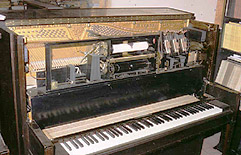
Player Piano, 1920
There are exceptions to this
rule, and it is no surprise that these instruments have some similarity
to electronic instruments. Consider for example a church organ, which
allows the performer to put some weights on the keys, and enjoy the
resulting cluster of sound without further action, or the mechanical
music toys capable of playing back compositions represented as an
arrangement of spikes on a rotating metal cylinder. The church organ
already is a remarkable step away from the intuitively understandable
instrument. The organ player is sitting somewhere, the sound comes
from pipes mounted somewhere else. Replace the mechanical air stops by
electromagnetic valves, and the player by a roll of
paper with punched holes, and the music can be performed with more
precision than any human could achieve.
The image above shows a Ampico-Player Piano from
Marshall & Wendell, made in the 1920s. It was used by composer Conlon
Nancarrow to realize compositions unplayable by human players.
The invention of electricity made much more complex "self playing"
instruments possible, and due to further technological progress in
electronics and computer science, those machines became small enough
to be affordable and sonically rich enough to make them interesting
for composers.
Nowadays two main types of electronic instruments exist - those which
are made for classical instrumentalists, mostly equipped with a
mechanical keyboard, and those for the composer, allowing for
recording, editing, and manipulating music. And all kinds in between.
If you replace a musician by a sound generating device directly
controlled by a score, you get rid of the unpredictable behavior of
that human being and you gain more precise control over the result. A
great range of historical computer music and certainly a huge portion
of the current electronic (dance) music has been realized without the
involvement of a musician playing any instrument in realtime. Instead,
the composer acts as a controller, a conductor and a system operator,
defining which element needs to be placed where on a timeline. This
process is of an entirely different nature from actually performing
music, since it is a non-realtime process, and is therefore much
closer to architecture, painting, sculpting, or engineering.

Roland TR-808. Editing patterns step by step, 1979
During the creation of electronic music this non-realtime process
allows for an almost infinite complexity and detail, since each part
of the composition can be modified again and again. New technologies
make this possible to a previously unthinkable extent. We live in a
world of musical undo and versioning. A computer is the perfect tool
for these kinds of operations, capable of storing numerous versions of
the same work, and also allowing for extreme precision in detail. The
general workflow is much more efficient than the complex classical
studio setup, with a giant mixing desk, lots of hardware units and
physical instruments, even with ten assistants running around all the
time. The result of working for several weeks with music software
might be a piece of audio which is the equivalent of two hundred
musicians, five huge racks of different effects units, and massive
layering of instruments. Very impressive, indeed. So, now go, put this
on stage...
chapter II - the tape concerts
At the very beginning of computer music, the only way to perform a
concert was to play back a tape. The so-called tape concert was born,
and the audience had a hard time accepting the fact that a concert
means someone pressing a play button at the beginning and stop button
at the end. Ironically, half a century later, this is what all of us have been
experiencing numerous times when someone performs with a laptop.
Trying to re-create a complex electronic composition live on stage
from scratch is a quite absurd and, most of the time, simply
impossible task.
The bottleneck is not that today's computers cannot produce all those
layers of sound in realtime, but that one single performer is not able
to control that process in a meaningful and expressive way. Even if
someone owned all of the instruments of an orchestra and even if that
person is capable of playing them all, it is obviously impossible for
this person to perform a symphony alone.

Trautonium 1935
The computer musicians of the mid 20th century had no alternative - the tape concert was the only way to present their work, since all
computer-generated music was realized in a non-realtime process; the
creation of the sound took much longer for the computer to calculate
then the duration of the sound itself. A situation which, for the
design or modification of more complex sounds, was quite normal until
a decade ago. This explains why the whole topic of live performance
with nothing but a laptop is so new. Even back in the 1930s there were
already real time electronic instruments, such as the Theremin or
Oskar Sala's Mixtur Trautonium. Built for a single player, and by
nature in expression and approach similar to acoustic instruments,
their complexity was nevertheless limited and they were never meant to
replace a full orchestra with one machine. For our purpose of finding
ways out of the laptop performance dilemma the tape concert situation
is of much more interest, since it is closer to what we do with our
laptops today.
Even while these concerts were referred to as tape concerts, there was
the notion of the speaker as the instrument. The speakers were what
the audience could see, and then there was the operator with his
mixing desk and the tape machine. The speakers were located on stage,
replacing the musicians, while the operator was sitting in the middle
of the audience or at the back of the room, but not on stage. Visually
it was clear that he was not the musician, but the operator. There was
a very practical reason for this. Similar to the role of the
conductor, the operator was the person controlling the sound of the
performance, and this could only be done by a placement close enough
to the audience. This became even more important once composers
started to use multiple speakers.
Multiple speaker tape concerts soon became situations with room for
expression by the operator. A whole performance school is based around
the concept of the distribution and spatialisation of stereo
recordings to multiple, often different sounding speakers, placed all
around the listener. The operator, similar to a good DJ, transports
the composition from the media to the room by manipulating it. The DJ
mixes sources together to stereo, the master of ceremony of a tape
concert distributes a stereo signal to multiple speakers dynamically
to achive the most impact. This can be a quite amazing experience, but
it certainly needs the operator to be in the eye of the storm, right
at the center of the audience.
[Image right: Francois Bayle performing with the "Acousmonium", a multi speaker arrangement he invented in 1974]
The DJ concept has a connection to the tape operator concept: Both are
taking whole recorded pieces and re-contextualize them. One by
diffusion in space, the other by combining music with other music. No
one in the audience listening to a choir on a record assumes that at
the moment she experiences that choir, some very tiny little singers
are having a good time inside a black disk of vinyl. We all know what
goes on and we judge the DJ by other criteria than the intonation of
the micro-choir inside the record. A good DJ set offers all we
normally expect from a good performance. We can understand the
process, we can judge the skills, and we can correlate the musical
output to input from the DJ; we have learned to judge the instrument
"turntable and mixer". The same is true for the distribution of pre-
recorded music to multiple speakers. There is a chance we understand
the concept and this helps to evaluate the quality of the performance
more independently from the quality of the piece performed.
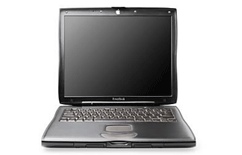
The first notebook fast enough to do real time audio processing 1999
Also a classic tape concert typically is annotated with some kind of
oral introduction or written statement, helping the audience to gain
more insight into the creation of the presented work. I find this kind
of concert situation quite interesting and I think it still could
serve as a model for today's presentation of various kinds of
electronic music. However, while in the academic music world tape
concerts are well accepted and understood, there seems to be a need
for electronic music outside that academic context to be "performed
live" and "on stage", regardless of whether this is really possible or
not. The poor producer, forced by record labels and his own ego, or
driven by the simple fact that he has to pay her rent, has to perform
music on stage which does not initially work as performance, and which
has never been "performed" or "played" during the creation at all.
When listening to one of those more or less pre-recorded live sets
playing back from a laptop, we have almost no idea of how to evaluate
the actual performance, and we might want to compare a completely
improvised set (which is indeed also possible now with a laptop if you
accept reduced complexity of interaction) with a completely
pre-recorded set. We have no sense for the kind of work carried out on
stage. What we see is that glowing apple in the darkness and a person
doing something we cannot figure out even if we are very familiar with
the available tools. This scenario is not only unsatisfying for the
audience but also for the performing composer. The audience cannot
really judge the quality of the performance, only the quality of the
underlying musical or visual work, but it might be fooled by a
pretentious performer, might compare a complete improvised
performance, full of potential failure, with a presentation of a pre-
composed and perfectly well-balanced work - without being able to
distinguish the two. Also the performer himself might want to be more
flexible, might want to interact more, or at least might feel a bit
stupid alone with his laptop on a 15 meter long 5 meter deep stage
with the audience staring at him, expecting the great show which he
will not deliver.
The classical tape concert, is an option which works well for scenarios
where pre-recorded pieces are presented, and this is made clear to the
audience and where there is room for the operator in the center or at least close to the audience and in front of the speakers. For those reasons it does not really work in a normal dance club context, or as a substitute for a typical rock' n' roll style "live" concert. If the tape concert is not an option, the key questions are:
how can I really perform and interact on stage and, how can I make the
audience aware of what goes on without having them read a long
statement or start the concert with a ten minute introduction...
chapter III - the golden age of hardware
Historically, academic computer music is closely connected to research
in instrument and interface design. And the typical concert audience
appreciates or at least accepts experimental setups of all kinds, even
if the result might be not 100% satisfying. I remember a concert years
ago in a church, during a computer music conference. In front of us on
tables was a battery of Silicon Graphics computer workstations, and
racks full of electronics of unknown origin.

The estimated value of
all that equipment surely did exceed the value of the church building
itself by far. Lights off, spot on, five performers taking their seats
behind the screens, the audience in silent expectation, while the
performers seemed to prepare for things to come. The sound of
concentrated hacking on computer keyboards, occasional clicks of a
mouse, and then finally one of the guys raised his left hand, armed
with a new interface device called a data glove. As a result of a
sudden dramatic gesture with his hand, with maybe a one second delay,
some loud and piercing sound emerged from the speakers, a long digital
version of a miauing cat or something like this, unfortunately not
embedded in mild clouds of reverb. The performers continued to stare
at their screens, with occasional mouse and keyboard actions, while
the one with the glove made more and more dramatic gestures, all
leading to various cat like moouuiiiiiioooooooooooouuuuuussssssss, and
each time this one second between the movement of the tactile device
and the output of the sound.
miiiiioooouuuuuuuuuuuuuuuuiiiiiioooooooooooooooooooooooooooo............
...............iuiuiuuiuiuiuiiiiiiiiiiiiiiiiiiiiiiiiiiiiiiiiiiiiiiiiiiii
iiiiiiiiiiiiiiiiiii............ Most of the audience seemed not to
find this particularly strange or funny but I had a hard time not
laughing out loud. And I was not even stoned. Data gloves did not make
their way into the mainstream music scene, but obviously a performer
doing something dramatic on stage which leads to an comprehensible
musical result had potential.
While the creation of academic computer music was, from the very
beginning, more of a non-realtime process than an actual performance,
the late sixties saw the development of the first commercial
synthesizers, equipped with a piano keyboard, and ready to be played
by musicians rather than operated by engineers. Suddenly, electronic
sound became accessible to real musicians - this led not only to
impressive stacks of Moog, Oberheim, Yamaha and Roland keyboards on stage but also to a
public awareness and notification of electronically created sounds.
The peak of this development was the stage shows of electronic
post-rock bands like Tangerine Dream and Kraftwerk in the late
seventies and early eighties.
What the audience saw was a bunch of
people hidden behind impressive amounts of technology, blinking
lights, large mixing consoles, and shimmering green computer terminals
... a showcase of the future on stage. It was impossible to understand
how all these previously unheard-of new sounds emerged from the
machines, but due to the simple fact that there masses of them and
total recall was not possible, the stage became a place where a lot of
action was needed throughout the course of the performance. Cables had
to be connected and disconnected from modular synthesizers, faders had
to be moved, large floppy disks were carefully inserted into equipment
most people had never even seen before, not to mention owning one of
these precious units, and more complex musical lines still had to be
played by hand. It was a happening, an event, remarkable and full of
technological magic; the concert was a unique chance to experience the
live creation of electronic music. And it was live. What was set up on
stage was nothing less than a complete electronic studio, operated by
a handful of experts in real time. Great theatre, great pathos, and
sometimes even great musical results.

Tangerine Dream live in London 1982
The giant keyboard stacks and effects racks not only looked good on
stage, they were the same kinds of instruments as the ones used in the
studio during the creation of the recordings preceding the live
concerts. Putting them on stage was the most straightforward and clear
way to perform electronic music and, since they were so incredibly
expensive, the costs of transport and maintanance did not matter so
much. If you could afford these tools you probably sold enough albums
to pay for transportation and to attract enough people for a stage
show. The classical rock scenario, music for the masses.
This is the past, the golden age of electronic super groups and the
times of super expensive hardware.
Starting from the late 1980s inexpensive computer technology changed
things dramatically. Creating electronic music became affordable for a
broader range of people with the advent of home computer-based MIDI
sequencing. This not only had an influence on the process of creation
but also on performance.
chapter IV - fame and minaturization
If the creation of electronic music is possible in a bedroom, it is also possible to put the content of this bedroom (minus the bed) on stage. Or right from the trunk of a car down to a dance-floor or temporal concert space established in the basement of an abandoned warehouse, without stage, right in front of the audience, preferably close to the bar. The revolutionary counterpoint to the giant stage shows of the previous decade was the low-profile, non-stage appearance of the techno producer in the early nineties. The equipment became smaller and the distance between performer and audience became smaller too. I remember nights in Berlin clubs at this time, where I spent my time watching guys operating a Roland TR-808 drum computer or muting patterns on a mixer or in their sequencers on their Atari computers. The music was rough, and its structure was simple enough to be decodable as the direct result of actions taken by the performers. Flashing lights on mixer, all fingers on mutes, eye contact with the partner, and here comes the break! Ecstatic moments, created using inexpensive and simple to operate equipment, right in amongst the audience. Obscure enough to be fascinating, but at the same time an open book to read for those interested, and in every case very direct and, yes!, live!!
It's the tragic effect of history that these moments come to an end, driven by the same forces enabling them in the first place. Computers became cheaper and more powerful, and more and more complex functions could be carried out hidden in a small box.

DJ Rush, Tresor Berlin, 1998?
This development changed electronic live performance in significant ways. The more operations that a computer in the bedroom studio was able to carry out, the more complex the musical output could be, and the less possible it was to re-create the results live. A straight techno piece made with an Roland TR-808 and some effects and synth washes can be performed as an endlessly varying track for hours. A mid 90s drum&bass track, with all its time-stretches, sampling tricks and carefully engineered and well-composed breaks is much harder to produce live, and marks pretty much the end of real live performance in most cases. To reproduce such a complex work one needs a lot of players, unless most parts are pre-recorded. As a result, most live performances became more tape concert-like again, with whole pieces played back triggered by one mouse click and the performer watching the computer doing the work.
This would all be fine, if performance conditions reflected this, but obviously it does not happen in most cases. Instead we experience performers who are more or less pretending to do something essential or carrying out little manipulations of mostly predefined music. The performer becomes the slave of their machine, disconnected from their own work as well as from the audience, which has to do with the second big motor of change: fame.
Fame puts the performer on stage, away from the audience. Miniaturization puts the orchestra inside the laptop. Fame plus miniaturization works very effectively as a performance killer.
When I started playing electronic music for audiences it was always in a very non-commercial situation, and I enjoyed this a lot. People came because of the music and not because there was a big name on a poster. Being close to the listeners enhanced the feeling of being part of a common idea.
That intimacy provided a highly communicative situation, where interaction with the audience was possible, if not desired. But once you reach a certain level of fame, it does not work anymore; the electronic artist, now internationally known after all the years in a musical underground, performs on stage and not next to the bar on a small table. The audience wants to be overwhelmed, they want to experience the idol, not the guy next door. The audience expects from a concert the same full-on listening experience as from records. And this is impossible to deliver in real time. But the star has not so much of a choice. He or she plays back more or less pre-recorded music. From a laptop. Far away from the audience. Elevated. Lonely.
Instead of letting the audience experience the great world of creating electronic music live, and instead of being capable of interacting spontaneously, the artist watches the music passing beneath the timeline, and tries to make the best out of it by applying effects.
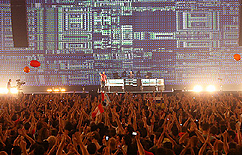
US techno superstar BT live 2007
This situation not only leads the audience to conclude the person on stage might be checking email or flight dates, but it is also extremely unsatisfying for the performer. Performing electronic music on a stage without acoustic feedback from the room, completely relying on some monitors, is quite a challenge and most of the time far from being fun for the artist. The sound would be so much better if we on stage could hear what the audience hears. The most horrible situation you can find yourself in is the classic rock setup. Two towers of giant speakers, bad floor monitors and a lonely performer behind a table, obscured by smoke, hiding behind the laptop. Usually no sound guy in the audience who has any real idea of what you're gonna do or how you want it to sound, and no band colleagues who could provide some means of social interaction; instead, there is just you and your laptop. The best recipe to survive this is to play very loud, with very low complexity and hope for an audience in a chemically enhanced mode.
Unfortunately most typical concert situations outside the academic computer music community do not support the idea of playing right in the middle of the audience. In a club, it is often impossible since there is the dance-floor and you do not want to be right in there with a laptop on a small table at four in the morning, and even if you do find a situation appropriate for a centered performance, maybe at a festival, after successfully arguing with a sound technician for several hours you might be confronted with the dynamics of the expectations of fans:
They want you elevated, they want you on stage, they want to look up to you, they want the show they are used to, and no 'weird experimental setup'.
There is an interesting difference between the computer music presenter and a live act. While the centered tape operator has perfect conditions for creating the best possible sound, for presenting a finished work in the most brilliant way (which might occasionally even include virtuoso mixing desk science rather than static adjustment to match room acoustics), the live act has to fight with situations which are far from perfect and at the same time is expected to be more lively. Given these conditions, it is no wonder that generally rough and direct live sets are more enjoyable, while the attempt to reproduce complex studio works on a stage seem more likely to fail.
A rough sounding performance simply seems to match so much more the visual information we get when watching a guy behind a laptop. Even if we have no clue about their work, there is a vague idea of how much complexity a single person can handle. The more the actions result in an effect like a screaming lead guitar, the more we feel that it is live. If we experience more detail and perfection we most likely will suspect we are listening to pre-prepared music. And most of the time we are right with this assumption.
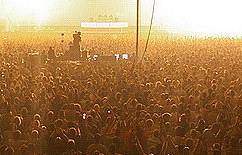
We could come to the conclusion that only simple, rough and direct performances are real performances, forget about complexity and detail and next time we are invited to perform we grab a drum computer, a cheap keyboard, a microphone, and make sure we are really drunk. It might actually work very well. But what to do, if this it is not what we want musically?
* The End *
A german version can be downloaded as Word Document here:
- Deutsche Fassung -






